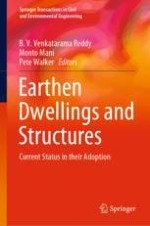This book presents selected papers presented during the International Symposium on Earthen Structures held in IISc Bangalore. The papers in this volume cover the theme of earthen structures, with technical content on materials and methods, structural design and seismic performance, durability, seismic response, climatic response, hygrothermal performance and durability, design and codes, architecture, heritage and conservation, and technology dissemination. This book will be of use to professionals, academics, and students in architecture and engineering.
